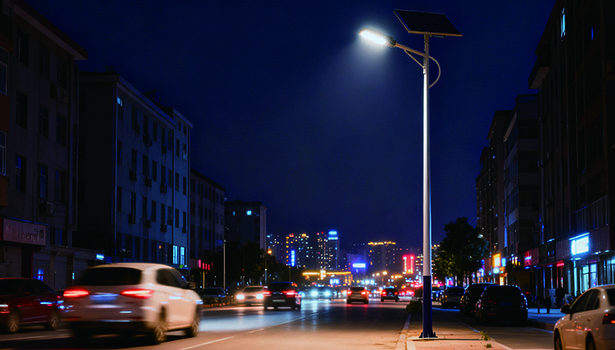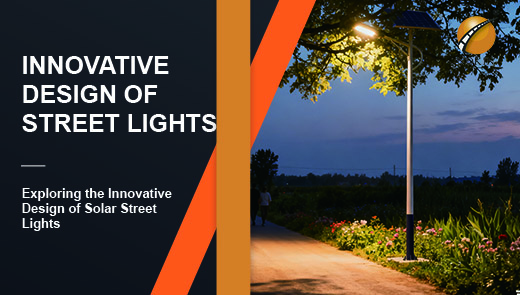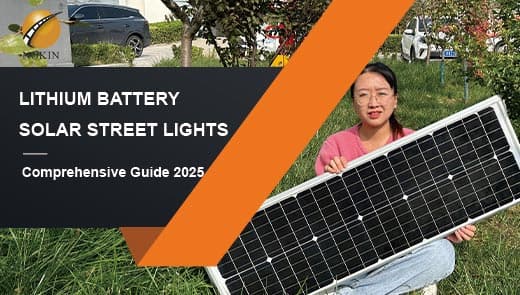Exploring the Innovative Design of Solar Street Lights
The innovative design of solar street lights has transcended basic illumination to achieve a profound integration of aesthetic expression, intelligent upgrades, and sustainability, establishing them as core infrastructure in modern urban and rural development. Amid accelerating global energy transitions and urbanization, traditional street lights face challenges such as high energy consumption, difficult maintenance, and outdated designs. This article analyzes the design innovations and core value of solar street lights from four dimensions—aesthetic design, functional innovation, practical application, and future trends—highlighting their vital role in contemporary urban and rural construction.

Design Aesthetics of Solar Street Lights
The Value of Design Aesthetics
Urban landscapes form a vital component of a city's identity. As a core element of streetscapes, the design aesthetics of solar street lights extend far beyond the visual realm. Exceptional design elevates solar street lights into urban focal points, embodying cultural heritage while conveying contemporary aesthetic concepts. This not only enhances a city's overall distinctiveness but also boosts residents' well-being through visual harmony.
From municipal thoroughfares to historic districts, from rural lanes to scenic trails, aesthetically versatile designs integrate solar street lights as organic components of urban and rural environments. This aligns with the “multi-pole integration” urban development philosophy, liberating public space resources.
Core Pathways for Aesthetic Innovation in Solar Street Lights
Form Innovation
Breaking away from traditional uniform designs, pursuing diverse forms and fluid lines. Streamlined designs follow aerodynamic principles, while biomimetic designs add artistic flair—such as the “lotus lamp” shape adopted in some cities, which, when illuminated at night, resembles lotus flowers blooming along the streets, creating a unique landscape. Wall-mounted designs emerge as a standout form, featuring 12mm ultra-thin bodies that seamlessly integrate with walls. Eliminating the need for poles or cantilevers, they enhance ground and aerial visual transparency, resembling metallic relief art.
Color Coordination
Color serves as the primary visual language, requiring solar street light designs to harmonize with their surroundings. Warm tones create cozy, inviting atmospheres, while vintage hues complement historic districts to enhance cultural depth. Natural color palettes blend seamlessly with rural landscapes, avoiding visual clashes.
Smart color-adjusting technology is increasingly applied, automatically adapting color temperature to architectural materials. Warm, orange-tinged light suits brick walls, while cool, blue-tinged light complements glass facades, ensuring lights integrate with their surroundings for precise visual and atmospheric alignment.
Material Selection
Premium materials ensure both aesthetics and durability. Corrosion-resistant, weatherproof aluminum alloy dominates as the primary lamp post material. Paired with transparent or translucent high-transmittance lampshades, it guarantees illumination while elevating overall quality. Customized finishes are increasingly popular, offering textures like exposed concrete, rusted metal effects, or jade-like glazes to match diverse architectural styles. Specialized products for unique environments incorporate tempered glass shades and all-steel structures, balancing protective performance with aesthetic appeal to elevate both functionality and visual experience.

Functional Design of Solar Street Lights
Core Functional Foundation
The core function of solar street lights is autonomous power generation through photovoltaic conversion, eliminating grid dependency. This feature not only reduces the burden on power systems but also significantly lowers operational costs and carbon emissions. Their energy logic revolves around “collection - storage - utilization.” Depending on regional sunlight conditions and road types, monocrystalline, polycrystalline, or amorphous silicon cells can be selected to match 12V/24V system voltages, meeting diverse lighting demands. Some products adopt “integrated wind-solar-storage-charging solutions,” combining wind and solar energy to further enhance supply stability, achieving dual goals of environmental sustainability and efficient operation.
Structural Design Differentiation
Integrated Structure
The integrated solar street light combines the solar panel, battery, controller, and LED light source within the lamp head. Installation is straightforward with no additional wiring required. Its modular design facilitates maintenance, while the sealed structure offers robust protection. Suitable for sidewalks, residential roads, parks, parking lots, and similar settings, it also meets temporary lighting needs, aligning with the demand for simplified infrastructure in small areas.
Split Structure
Split solar street light components are installed separately. The solar panel is independently mounted, while the battery is buried underground or installed at the base of the light pole. This configuration allows for larger-capacity components, superior heat dissipation, and higher energy storage and generation efficiency. It is suitable for scenarios requiring high illumination intensity, such as urban main roads and highways, and can meet long-distance, high-brightness lighting demands.
Smart Upgrades
Smart Control System
Equipped with an MPPT controller that tracks maximum power point of solar panels, boosting charging efficiency by 15-20%. Integrated with light control, time control, and remote control systems for fully autonomous operation. LED fixtures support continuous dimming from 0% to 100%, flexibly adjusting light output based on ambient light and traffic conditions to maintain illumination quality while reducing unnecessary power consumption.
Environmental Adaptation Optimization
Utilizes lithium iron phosphate or power lithium batteries with a cycle life exceeding 3,000 cycles. Supports stable operation across temperatures ranging from -30°C to +70°C. Select models deliver 5-7 days of continuous operation during rainy weather. Specialized environmental adaptation features continuously evolve: automatic thermal cycling at low temperatures prevents freezing, while high-temperature switching activates rapid heat dissipation mode. Equipped with self-cleaning breathable membranes that utilize rainwater runoff to maintain light transmission, reducing maintenance needs and adapting to diverse climatic regions.

Energy Storage & Efficiency
Innovative Energy Storage Combination
LED light sources paired with super capacitors achieve over 100,000 hours of LED lifespan, reaching 50,000 hours under optimal cooling conditions. Minimal light decay extends product longevity while enhancing charging efficiency and environmental sustainability. Some brands' fin-type LED fixtures further optimize thermal structures, boosting heat dissipation efficiency by 30%. Integrated LED-specific heat sinks maintain body temperatures ≤50°C during prolonged operation. Constant-current circuits employ distributed independent power supply systems, significantly reducing light source failure rates.
Demand-Based Lighting Mode
Time-based brightness adjustment is standard. Neighborhood Mode automatically reduces brightness by 30% after 10 PM to prevent light pollution affecting adjacent windows. During late-night periods with sparse foot traffic, the system switches to energy-saving mode, restoring normal brightness at dawn. This maximizes energy efficiency while meeting lighting requirements. Such design enables annual electricity savings of hundreds of kilowatt-hours per lamp, significantly reducing carbon emissions and supporting carbon peak and neutrality goals. Some industrial zones further optimize energy consumption with a half-power operation mode during the latter half of the night.
Solar street light Application Case
Municipal Road Scenario
In urban main road projects, street lights are predominantly arranged symmetrically on both sides. The poles stand 10m tall with 1m cantilever arms, spaced 28m apart. Light sources feature 135W for main roads and 80W for bicycle lanes. Through triple optical distribution design, the luminaires achieve an overall luminous efficacy of 50lm/W, with an average illuminance of 18 lux and uniformity of 0.4, providing optimal lighting conditions for traffic flow.
The project, featuring 99 multi-functional smart streetlights, has created China's first "zero-carbon digital road demonstration section." Each streetlight pole integrates photovoltaic panels, a micro wind turbine, and an energy storage unit, generating approximately 320 kilowatt-hours of electricity annually, while also providing fast and slow charging services.
Historic District Scenario
Retro-styled wall-mounted solar street lights feature a 12mm ultra-thin body that seamlessly integrates with ancient building facades. A specialized installation system avoids structural damage to walls, preserving historical aesthetics while meeting lighting standards. Warm-toned lighting and anti-glare lenses balance cultural expression with practical needs, achieving harmonious coexistence between heritage conservation and modern infrastructure.
Rural Town and Village Scenarios
200W integrated solar street lights feature monocrystalline photovoltaic panels with 18% conversion efficiency, supporting 3-5 days of operation during cloudy or rainy weather. IP65 waterproof certification paired with hot-dip galvanized and powder-coated poles delivers wind resistance up to 150km/h, making them ideal for rural infrastructure conditions with outstanding cost-effectiveness. Some solar street lights incorporate integrated “light-storage-charging” design, eliminating wiring and electricity costs while achieving up to 100% energy savings. This reduces annual carbon dioxide emissions by approximately 4,800 tons, supporting rural green energy transition.
Special Application Scenarios
Solar explosion-proof street lights, certified with EX rating, feature all-steel construction and IP66 protection. Suitable for high-risk environments like gas stations and chemical plants, their smart control systems integrate leakage protection and fault alerts, balancing safety requirements with intelligent management.
For factory roadways, lights are typically arranged in alternating pairs on both sides. With 6.5m poles spaced 20m apart and 30W light sources, they meet the 15lx ground illumination requirement, catering to factory operational lighting needs.
Residential communities flexibly deploy standalone, high-specification, or centralized solar street lights based on lighting conditions. The centralized system addresses insufficient illumination in high-rise complexes, featuring IP65-rated luminaires with extended lifespan and low power consumption.
The innovative design of solar street lights represents a profound integration of aesthetic expression, intelligent technology, and sustainable principles. They not only resolve the energy consumption and maintenance challenges of traditional outdoor lighting but also serve as vital carriers for shaping urban and rural landscapes and advancing smart infrastructure development. In the future, solar street lights will transcend their role as mere lighting tools to become core infrastructure for building green smart cities, injecting sustained green momentum into urban and rural development.




